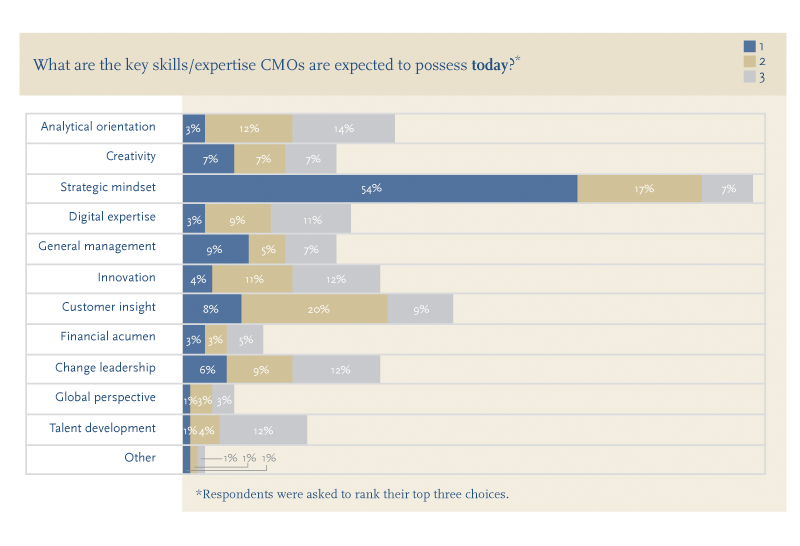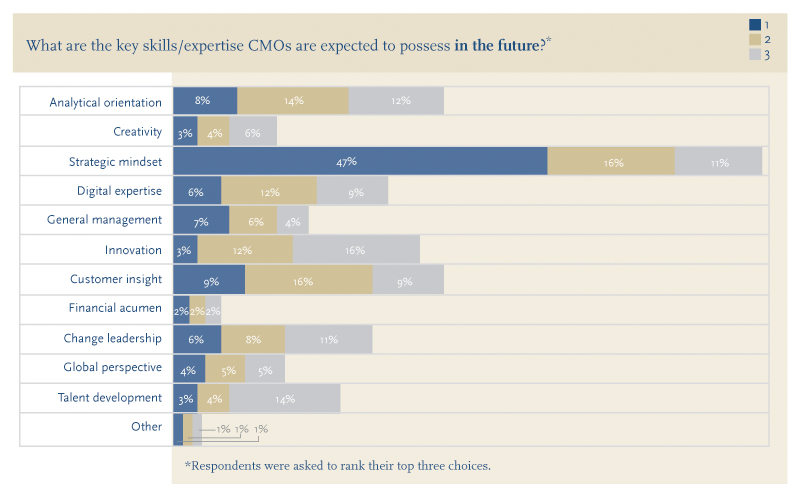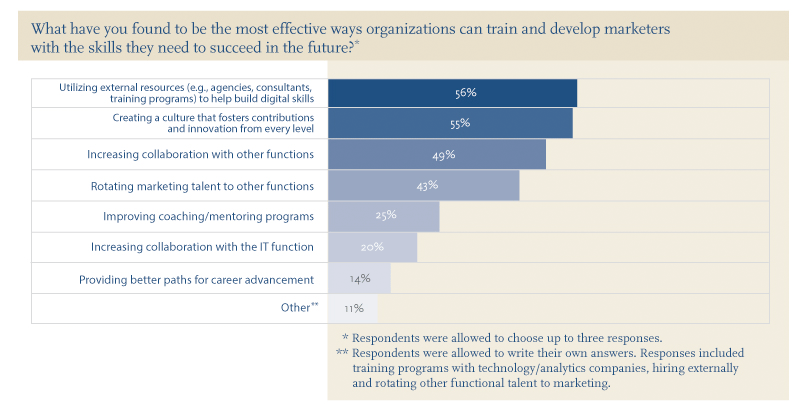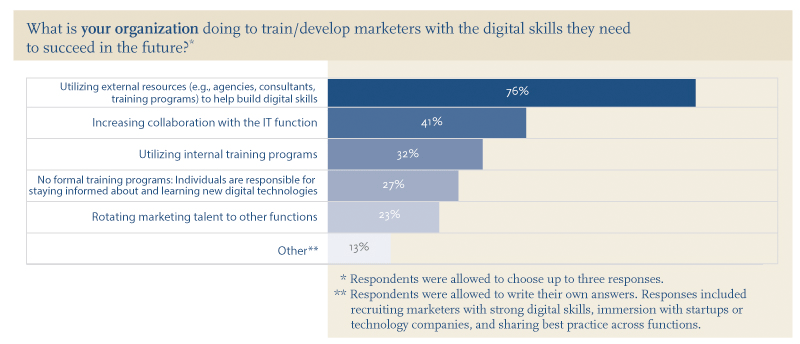Tomorrow’s CMO: Chief Magic or Logic Officer? [REPORT]
May 22, 2014
![]() By Arthur S. Brown, Grant Duncan, Thomas Seclow, Greg Welch
By Arthur S. Brown, Grant Duncan, Thomas Seclow, Greg Welch
Digital has become a key driver of business decisions across industries, with a significant number of those choices falling under the marketing function. Digital and its possibilities continue to impact the role of the CMO, but is there a danger that by placing so much emphasis on analytical skills, marketing leaders may be overlooking other vital skills? What skills will the CMO of the not-so-distant future need to be successful? To help answer these questions, Spencer Stuart surveyed more than 160 senior marketing leaders in advance of our annual CMO Summit, spanning the consumer, financial services, technology, life sciences, industrial, media and advertising, and nonprofit sectors.
Interestingly, even in an era of big data and unprecedented access to information shared by consumers, the majority of those surveyed believe that creativity is just as important as analytical ability for current and future marketing leaders. Yet, far fewer respondents feel their teams strike the right balance. The challenge is finding and competing for leaders who have a command of both the art and science of the function in a limited talent pool. Our survey findings and discussions with senior marketing leaders explore the growing list of desired skills, sources of this multi-skilled talent, and ways companies can develop top marketers for the future.
Marketing leaders believe balance is necessary, but few have found it
A significant majority (70%) of survey respondents said that creativity and analytical ability have been equally important for marketing leaders over the past few years as digital has become a more central requirement of the function. Less than one-third (29%) said analytical ability takes primacy and only 1% deemed creativity the main priority for marketing skills.
While most marketing leaders believe a combination of the two orientations is important, only 19% believe their teams strike the right balance between creativity and analytics; 29% said their teams’ skill-sets skew more toward the creative side. More than half (52%) said their teams are more analytical, further evidence that marketing leaders have been building up their teams with people who are strong in analytics.
Data and analytical tools have become increasingly important to the function as a way to better understand the customer, but they are just the starting point for customer engagement. “As we get more precise data that can tell us a lot more about the consumer than ever before, it is tempting for that to be the endpoint,” said Mark Addicks, senior vice president and chief marketing officer for General Mills. “For instance, a team will say, ‘We now know this is when the customer actually consumes the product versus what we used to think in terms of time of year, time of day, specific day, etc.’ In my mind, this information gives you a better starting point, a better way to assess where you can engage consumers, but it’s not the endpoint. You still need a creative idea that engages them.”
David Roman, senior vice president and chief marketing officer of Lenovo, cautioned that there is a risk of becoming too enamored with data: “The risk is that we get so caught up in data and the analysis of it that we lose sight of the ultimate objective.” The key, according to Tony Palmer, president of global brands and innovation for Kimberly-Clark Corporation, is to use analytics to enable and enhance creativity. “We set up these false paradigms intellectually, with science being the enemy of creativity and creativity being the enemy of science,” he said. “My observation throughout my career on creativity has been that the more structured you are, the more disciplined you are, the more scientific your work is and the more focused you are, the better the creativity you unleash,” he said. “I have a perspective that they are not in conflict, but on the contrary, can be perfectly correlated.”
Most respondents (78%) expect that future marketing leaders will bring a blend of creativity and analytical orientation; 11% anticipate future marketing leaders will have an analytical background and 1% expect a creative orientation. Some respondents remarked that the combination of creativity and analytics in future marketing leaders will need to be supplemented by strategic ability, consumer acumen and technology knowledge.
Alison Lewis, global chief marketing officer of Johnson & Johnson’s consumer companies, believes the balance digital demands of marketing leaders is actually one between ideas and their brand-driving impact. “What becomes really important for a CMO is to keep the balance between the bigness of the ideas and being really clear that these big ideas will drive against brand objectives, and that digital is a channel through which they are executed,” said Lewis. “I always use the analogy of the pinball machine — in today’s world, you want that ball to go into play and you want one touch point to bounce to the next, to the next and to the next, and for the ball to never go down. The beauty of social and digital is you have a much greater ability to amplify ideas to deliver the intended results.”
For Matt Atkinson, CMO of multinational British grocery retailer Tesco, the very foundation of marketing endeavors needs to be revisited. “You have to re-imagine logic and creativity into a different tapestry — and that is the customer experience. Marketing leaders need to think about insights in a new way, especially given the real-time feedback we are now receiving from customers. But more importantly, you have to act on that feedback. Insights are nothing unless they lead to different action.”


Sources of creative and analytical talent
Finding talent with a proper blend of the creative and analytical is a challenge, especially amid fierce competition for the scarce digital experts with both skills. Compounding the challenge is the fact that there is no single go-to source for talent, according to survey respondents; one senior marketing executive aptly described the task as finding “a few needles in loads of haystacks.” The vast majority (91%) of respondents look externally for talent with affinities for both the creative and analytical.
Competitors within the sector were viewed as viable sources of talent for 22% of respondents; 16% look to the technology industry; and another 16% tap historically creative sectors such as advertising and media. More than one-third (37%) said they find talent from “other” sources, including strategy consulting firms and startups to analytics companies and other sectors (e.g., consumer products, retail, financial services). Fewer than one in 10 respondents (9%) look for the combination of creative and analytical talent within their own marketing teams.

Some CMOs have turned to young, external talent with nonconventional backgrounds because they tend to be naturally more entrenched in digital. “We are bringing in a lot more young people with less traditional experience and trying to get people straight out of school,” said Roman. While Mark Baynes, senior vice president and global chief marketing officer of The Kellogg Company, has turned to outside talent to build his digital team, he also “looks down the organization” to less seasoned brand managers as sources of talent — and ideas.
“Often, I spend time with brand managers at the junior levels because they truly understand how the consumer is using this stuff, how it is knitting together and how to apply ideas seamlessly,” Baynes said. “It’s also pretty inspiring to see a senior leader come down and ask, ‘How do you do that?’ When I joined, my boss knew everything; the senior leaders had written the book. The book is now being written at a junior level — you have a chance to contribute, to shape, mold and build the playbook of the future. You have a whole organization where every level can help shape how brands are being built.”
Skills of today’s and tomorrow’s CMOs
Strategic mindset was by far the No. 1 desired skill for today’s CMOs by the majority of respondents (54%). “You’re trying to find people who know how the dots are joined together, and that is a skill-set that’s more and more important,” said Baynes. Strategic mindset remained the top priority for future CMO skill-sets for 47% of respondents. General management was deemed the top skill for today’s CMOs by the next-greatest share of respondents (9%).
One in five (20%) consider customer insight the No. 2 skill for CMOs to possess today; 16% consider it the No. 2 skill for CMOs of the future and only 9% believe it is the most important skill for the future. “I think the underrated discipline in marketing is consumerism and the ability to deliver to the consumer,” said Palmer. “Consumer understanding is what’s driving all of our digital efforts.” He also believes that the marketing and general management skills needed to lead these efforts are not mutually exclusive. “It’s a false dichotomy to consider that a general manager is different than a marketer; in fact, they’re one and the same,” he added.
Additionally, the CMO’s leadership cannot be isolated to marketing. As digital continues to blur the lines between functions, CMOs will play an integral part in helping to drive organization-wide collaboration. “What is underrated is the CMO’s role in cultural transformation,” said Atkinson. “The CMO has to make sure the story is clear. The words and actions have to match and the whole business has to be lined up to support the narrative. You work on culture as CMO as much as you do on marketing. The leaders who will make the future are those who are collaborative, possess humility and are outcome-driven.”


Developing tomorrow’s CMOs
The laundry list of desired skills for marketing leaders continues to grow: analytical orientation, creativity, strategic mindset, digital expertise, general management, innovation, customer insight, financial acumen, change leadership, global perspective and talent development. Rightfully so, many marketers are wondering if it will be possible to find leaders with all of these skills or if this is simply a hunt for the proverbial unicorn. Interestingly, the majority (86%) of respondents believe it will be realistic to expect to find this full gamut of skills within one person in the future.
But not all are confident this multi-skilled talent pool will la st forever. Lewis anticipates that the pool will dwindle over the next two decades: “We had a balance of people that were young and partly experienced in the digital space down to people who were very experienced and sort of reinvented themselves in digital careers over the last 10 years. But in 10 to 20 years from now, we’re going to have a gap in the talent as specialization re-emerges.”
The best way to combat that talent gap is through talent development, and yet, 89% of respondents do not believe organizations in general are doing a good job of training/developing future marketing leaders with diverse skills. More than one-quarter (27%) of survey respondents said their organizations do not have formal training programs to help develop marketers with the digital skills they will need in the future.
At times, there can be a misconception that training is not a worthwhile use of time and can interrupt the pertinent work at hand. Keith Weed, chief marketing and communication officer at Unilever, has both confronted and dispelled this myth in his own organization, putting an incredible 3,500 employees through digital training. “I always talk about how training is seen as a distraction from your real job and is not always highly regarded in business, but training is exactly what Olympic athletes do all the time and accept it as a way of being brilliant,” he said. “I want to employ brilliant people and make them even better by giving them the tools they need. I’m very upfront about how training is the way we’re going to stay ahead of everyone else.”
To further develop his marketing leadership bench, Addicks rotated a high-potential young marketer to one of General Mills’ more traditional brands, giving him the directive to act as a “change agent.” He empowered the marketing leader to design and drive the changes, and also exposed him to leaders throughout the broader organization and board as part of his career development and advancement plan.


Board expectations for marketing in a digital environment
Digital presents vast opportunities for organizations to gain unprecedented insights on customer behavior and to connect with customers in more targeted ways — but requires that organizations make significant investments in technology resources and talent. As a result, boards are placing more scrutiny on digital initiatives, and many marketing leaders reported that their boards have heightened expectations for demonstrated ROI.
One survey respondent noted the continued need to educate boards of directors on both the possibilities and limitations of digital: “Our board wants faster action with clear metrics. There seems to be a misconception that digital is somehow ‘free’ and that it is entirely metrics-driven. There needs to be more research into the real role digital can and does play in the marketing mix. It is certainly not a silver bullet.”
Survey respondents also said that their boards expect the marketing function to deliver a clear strategy, revenue growth, improved connections to customers and brand-building.
Conclusion
Digital has had a significant impact on the marketing function and, as technology continues to evolve, so will the profile of marketing leaders. Although analytical skills will be vital as companies pursue the possibilities of digital, most marketing leaders believe that the art and science of marketing go hand in hand. With a limited pool of talent that combines the creative and analytical, current marketing executives must invest in creating their own marketing magic and develop tomorrow’s marketing leaders today.
Profile of survey respondents*
The greatest share of survey respondents (38%) came from the consumer industry, 21% came from financial services and 15% from “other” sectors, including telecommunications, retail, entertainment and travel; 13% of respondents work in the technology industry, 7% in life sciences/healthcare, 5% in media, 5% in advertising, 3% in nonprofit and 1% in industrial.
*Percentages may not total 100 because respondents were allowed to select multiple answers.






























